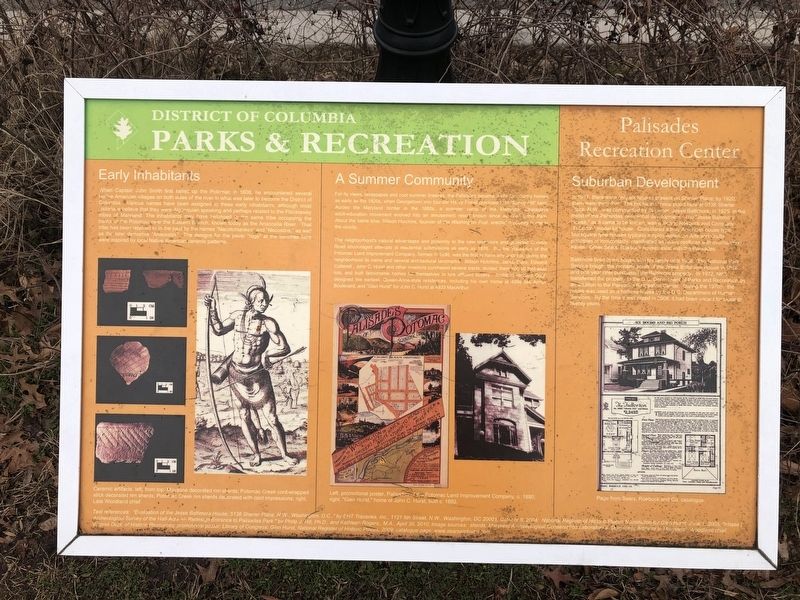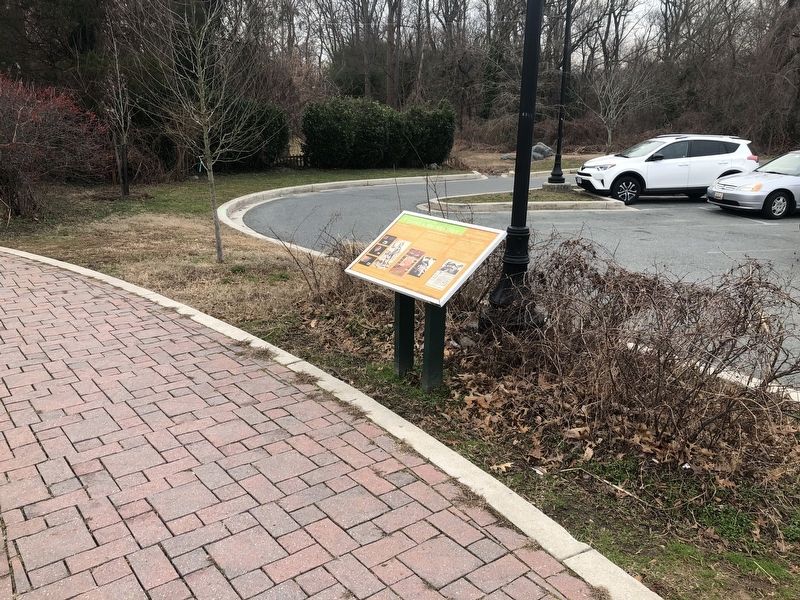The Palisades in Northwest Washington in Washington, District of Columbia — The American Northeast (Mid-Atlantic)
Palisades Recreation Center
District of Columbia Parks & Recreation
Inhabitants
When Captain John Smith first sailed up the Potomac in 1608, he encountered several Native American villages on both sides of the river in what was later to become the District of Columbia. Various names have been assigned to these early inhabitants, although most historians believe that they were Algonquian speaking and perhaps related to the Piscataway tribes of Maryland. The inhabitants may have belonged to the same tribe occupying the banks of the Potomac near the Eastern Branch, known today as the Anacostia River. That tribe has been referred to in the past by the names "Nacotchtankes" and "Necostins," as well as the later derivative "Anacostin." The designs for the paver "rugs" at the benches here were inspired by local Native American ceramic patterns.
A Summer Community
For its views, landscapes and cool summer breezes, the Palisades became a site for country homes as early as the 1820s, when Georgetown iron founder Henry Foxall purchased his "Spring Hill" farm. Across the Maryland border in the 1880s, a summer camp of Methodist Chatauqua adult-education movement evolved into an amusement resort known since as Glen Echo Park. About the same time, Stilson Hutchins, founder of The Washington Post, erected a country home in the vicinity.
The neighborhood's natural advantages and proximity to the new reservoirs and graveled Conduit Road encouraged attempts at residential subdivisions as early as 1876. But the Palisades of the Potomac Land Improvement Company, formed in 1890, was the first to have any success, giving the neighborhood its name and several architectural landmarks. Stilson Hutchins, Jacob Clark, Edward Cotterell, John C. Hurst and other investors purchased several tracts, divided them into 50-foot-wide lots, and built fashionable homes for themselves to lure affluent buyers. Architect Richard Ough designed the earliest, Queen-Anne-style residences, including his own home at 4898 MacArthur Boulevard, and "Glen Hurst" for John C. Hurst at 4933 MacArthur.
Suburban Development
In 1917, there were only six houses present on Sherier Place; by 1920, there were thirty-five. The house that once stood here at 5136 Sherier Place, N.W., was constructed by its owner, Jesse Baltimore, in 1925, in the midst of the Palisades residential development. The "Jesse Baltimore House," as it came to be known, was a Sears, Roebuck and Company "Fullerton" model kit house. Considered a truly American house type, foursquare-type houses typically employ American Arts and Crafts principles of horizontality, manifested as heavy rooflines with overhanging eaves. Other Sears, Roebuck houses exits with the Palisades.
Baltimore
Erected by DC Department of Parks and Recreation (DPR).
Topics. This historical marker is listed in these topic lists: Agriculture • Anthropology & Archaeology • Architecture • Exploration • Industry & Commerce • Native Americans • Parks & Recreational Areas • Settlements & Settlers • Waterways & Vessels. A significant historical year for this entry is 1608.
Location. 38° 55.5′ N, 77° 6.201′ W. Marker is in Northwest Washington in Washington, District of Columbia. It is in The Palisades. Marker is on Sherier Place Northwest just south of Edmunds Place Northwest, on the right when traveling south. Touch for map. Marker is at or near this postal address: 5136 Sherier Place Northwest, Washington DC 20016, United States of America. Touch for directions.
Other nearby markers. At least 8 other markers are within walking distance of this marker. The General Lafayette sign on the side of the garden… (within shouting distance of this marker); As you are on the old Glen Echo Trolley line… (within shouting distance of this marker); World War II (about 400 feet away, measured in a direct line); Navigation of the Potomac (approx. 0.4 miles away); Abner Cloud House (approx. 0.4 miles away); Glenmore (approx. half a mile away in Virginia); Battery Kemble Park (approx. half a mile away); Carolina Park: Archaeology and History in the Palisades (approx. half a mile away). Touch for a list and map of all markers in Northwest Washington.
Credits. This page was last revised on January 30, 2023. It was originally submitted on January 31, 2020, by Devry Becker Jones of Washington, District of Columbia. This page has been viewed 243 times since then and 20 times this year. Photos: 1, 2. submitted on January 31, 2020, by Devry Becker Jones of Washington, District of Columbia.

